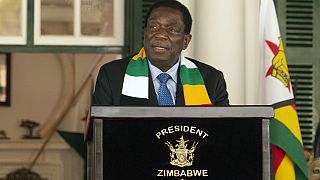Zimbabwe
When GPS-triggered alerts show an elephant herd heading toward villages near Zimbabwe's Hwange National Park, Capon Sibanda springs into action. He posts warnings in WhatsApp groups before speeding off on his bicycle to inform nearby residents without phones or network access.
The new system of tracking elephants wearing GPS collars was launched last year by the Zimbabwe Parks and Wildlife Management Authority and the International Fund for Animal Welfare (IFAW).
It aims to prevent dangerous encounters between people and elephants, which are more frequent as climate change worsens competition for food and water.
"Whatever I see on the road, the spoors (tracks), whatever I come across, that’s unusual in the bush, I record it," says Sibanda, one of the local volunteers trained to be community guardians.
For generations, villagers banged pots, shouted or burned dung to drive away elephants. But worsening droughts and shrinking resources have pushed the animals to raid villages more often, destroying crops and infrastructure and sometimes injuring or killing people.
Increasing conflicts between locals and wildlife
Zimbabwe's elephant population is estimated at around 100,000, nearly double the land’s capacity.
The country hasn’t culled elephants in close to four decades. That's because of pressure from wildlife conservation activists, and because the process is expensive, according to parks spokesman Tinashe Farawo.
Conflicts between humans and wildlife such as elephants, lions and hyenas killed 18 people across the southern African country between January and April this year, forcing park authorities to kill 158 “trouble” animals during that period.
Senzeni Sibanda, a local councillor and farmer is tending her tomato crop with cow dung manure in a community garden that also supports a school feeding program. "Drought is getting worse and the elephants devour the little that we harvest," she says.
"We have a big problem with elephants, but we found them here, they use the same roads, same grazing areas and water sources. These elephants also know when our harvest is ready in the fields", the farmer adds.
A new tactic: technology
Through the EarthRanger platform introduced by IFAW, authorities now track collared elephants in real time. Maps show their proximity to the buffer zone — delineated on digital maps, not by fences — that separate the park and hunting concessions from community land.
At a park restaurant one morning, IFAW field operations manager Arnold Tshipa monitors moving icons on his laptop as he waits for breakfast. When an icon crosses a red line, signalling a breach, an alert pings.
“Collaring helps us to understand the movement of animals within these human wildlife areas, or corridors per se," says Tshipa, before adding: "We are going to be able to see the interactions between both wildlife and people. This then allows us to give more resources to particular areas.”
The system also logs incidents like crop damage or attacks on people and livestock by predators such as lions or hyenas and retaliatory attacks on wildlife by humans. It also tracks the location of community guardians like Capon Sibanda.
"Every time I wake up, I take my bike, I take my gadget, then I hit the road," says Capon Sibanda. He collects and stores data on his phone, usually with photos.
His commitment has earned admiration from locals, who sometimes gift him crops or meat. He also receives a monthly food allotment worth about $80 along with internet data.
Tracking is helping - but not enough
Villagers like Senzeni Sibanda say the system is making a difference: "We still bang pans, but now, we get warnings in time and rangers react more quickly," she says. Still, frustration lingers. Sibanda has lost crops and water infrastructure to elephant raids and wants stronger action.
Her community, home to several hundred people, receives only a small share of annual trophy hunting revenues, roughly the value of one elephant or between $10,000 and $80,000, which goes toward water repairs or fencing.
She wants a rise in Zimbabwe's hunting quota, which stands at 500 elephants per year, and her community's share increased. The elephant debate has made headlines.
In September last year, activists protested after Zimbabwe and Namibia proposed slaughtering elephants to feed drought-stricken communities. Botswana’s then-president offered to gift 20,000 elephants to Germany, and the country’s wildlife minister mock-suggested sending 10,000 to Hyde Park in the heart of London so Britons could “have a taste of living alongside elephants”.
Zimbabwe's collaring project may offer a way forward.
Sixteen elephants, mostly matriarchs, have been fitted with GPS collars, allowing rangers to track entire herds by following their leaders.
But Hwange holds about 45,000 elephants, and parks officials say it has capacity for 15,000.
Project officials acknowledge a huge gap remains.












Go to video
Putin hosts talks with African leaders on security
Go to video
Over 100 vultures dead after eating poisoned elephant in South Africa
Go to video
Hope floats in the Amazon as young manatee Bacuri fights for survival
11:14
Power Play or Partnership? America’s Strategy in Africa [Business Africa]
Go to video
Newborn Masai giraffe calf makes first appearance at San Diego Zoo
Go to video
Harare City Council says bedbug infestation confined to only one locality